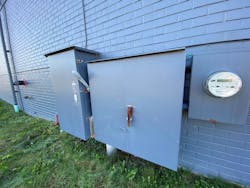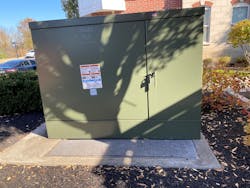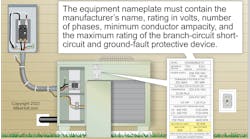This article will give electrical apprentices quick tips on industry-recommended practices, electrical service installation tips, and instructions for efficiently navigating an essential article in Chapter 2 (Wiring and Protection). As you start your journey to understand the NEC's layout, purpose, and structure, you will begin to rely on its neatly organized guidelines for all of your day-to-day tasks. Remember that the local authority having jurisdiction (AHJ) will enforce these guidelines nationally; use these practices wherever you work. In addition, Art. 230 (Services) sets the minimum standards for installation, so be prepared to do more if local jurisdictions require you to.
Understanding Figure 230.1
At the beginning of Art. 230, you will find a directory (Figure 230.1) that illustrates a main electrical services/system that delivers power to homes, commercial buildings, and industrial facilities from the electric utility company connection (tie-in), all the way down to the branch circuits feeding the building. Figure 230.1 is a time-saving directory/illustration that makes navigating the entire Article easy and efficient.
Electricians seeking installation guidelines for an aerial service with overhead wires called a tri-plex can find guidelines at the top left of the directory/illustration. Electricians seeking installation, repair, or modification guidelines for underground electrical service wires called a service lateral can find the guidelines at the top right of the directory/illustration.
The next stop for the electrical service is the metering. Typically, you can find these guidelines from the local electric utility company or the local AHJ. For example, in Philadelphia, I use a set of electrical construction guidelines for metering and electrical service from the "Blue Book." This publication is designed specifically for contractors and builders requesting power and metering by the utility company. This manual explains:
- The type, model, and manufacturer of the meter socket(s) required to receive electrical service.
- The method, type, and rating of the electrical metering used to bill the customer (e.g., watt-hour meter or current transformers). Typically, the power company provides this equipment and remains responsible for its maintenance.
- The location of the metering equipment for access by the power company.
Remember, these installation guidelines must be used in conjunction with any clearances or conditions set by the local electric utility company or requirements by the AHJ.
Standard (U.S.) voltage systems for electrical services
Here in North America, our standard voltage system(s) provided by the electric utility companies on the secondary side of their transformers are:
- 120/240V single-phase service (three-wire system): residential homes, multi-family dwellings, small commercial buildings
- 208/120V three-phase wye system (four-wire system): multi-family dwellings, commercial buildings, light industrial buildings
- 480/277V three-phase wye system (four-wire system): multi-family dwellings, commercial buildings, industrial buildings and plants
- 600/480V three-phase delta system (four-wire system): industrial buildings and plants (manufacturing facilities)
Older additional systems still in service in some areas:
- 240/208/120V three-phase (high-leg four-wire wye system): Commercial Buildings, Light Industrial Buildings
- 120/240V two-phase (four-wire system): Commercial Buildings, Industrial Buildings and Plants
A building can have more than one service
Under special conditions, an additional service can be installed: to supply a fire pump [Sec. 230.2(A)(1)] or enhance reliability [Sec. 230.2(A)(6)]; for ventilation systems or legally required standby systems; and where it may be essential to maintain life, alarm systems, elevators, public safety communications systems, and industrial processes where current interruption would produce serious life safety or health hazards [230.2(A)(3)]. An additional electrical service can be installed under special permission for Chapter 5 Special Occupancies where:
- There is no available space for service equipment accessible to all occupants; or where a single building or other structure is large enough to make two or more services necessary.
- If the load or capacity requirements are more than 2,000A at a supply voltage of 1,000V or less.
- Where the load requirements of a 120/240V single-phase installation are more significant than the serving agency (power company) typically supplies through one service.
- Additional service(s) may also be permitted if a building requires different voltages, frequencies, or phases, or for various uses, such as for different rate schedules; it can be granted under “different characteristics."
Running service conductors through a building
An electrical contractor may need to relocate a main electrical service to a more suitable location for various reasons. Sometimes, this is required to avoid installing the service equipment in an area that floods or simply placed in a location where it's more accessible for all tenants. This situation is typical in residential new construction homes to hide the service equipment away from the building's facade. This situation may require the electrical contractor to run service conductors through a building. This type of installation is permissible under the following conditions. The conductors must be protected in a reinforced manner; they must be considered outside the building. The conductors must be installed in not less than 2 in. of concrete beneath a building or other structure; additional guidelines may apply to any raceways or conductor insulation types used. The conductors must be installed in a raceway that is encased in concrete or brick at least 2 in. thick.
Clearances for service conductors on buildings
Energized service conductors can be very dangerous; they carry the unlimited potential to cause harm and damage if not installed correctly. The NEC lays out guidelines for installing service conductors that keep safe personnel, building owners, and the properties that we provide electrical services to.
An important aspect of Art. 230 is following the strict guidelines that keep energized service conductors away from unintentional contact from trucks, moving equipment, or construction personnel working around them. Overhead service conductors such as multi-conductor cables without an overall outer jacket shall not be readily accessible.
Article 100 explains that this means "without the assistance of a portable ladder" or lifts, they should not be within reach; keep them at least 3 ft. from windows that are designed to be opened, doors, porches, balconies, ladders, stairs, fire escapes, or similar locations. The exception is that conductors running above the top level of a window shall be permitted to be less than the 3-ft. requirement.
Note to remember
The guidelines in Art. 230 are not for installations under the exclusive control of the local electric utility, communications company and their structures; this includes the buildings, equipment, and conductors that these companies own, control, and maintain (e.g., service drops or service laterals, or any associated metering). The NEC does not cover their equipment or conductors on property owned or leased by the electric utility for communications, metering, generation, control, transformation, transmission, or distribution of electric energy.
The NEC does not cover the installations of companies that control communications systems (e.g., telephone, CATV, Internet, satellite, or data services). So, in simpler terms, companies with exclusive control over these conductors, equipment, or generation systems are subject to the codes and standards set by the public service/utility commissions or their regulated industry.
Here's how I like to simplify what the NEC covers — the electrical contractor's installation(s) from the basement to where the service conductors tie into the electric utility company's wires or transformers. However, the Code does not cover the equipment or conductors beyond where we tie into the electric utility company.
Harold DeLoach, a master electrician and electrical trainer/instructor, is the founder of The Academy of Industrial Arts (www.taia-school.com) in Philadelphia. With more than 30 years of experience in the field, he will be writing regular exclusive content for E-Train and can be reached at [email protected].






